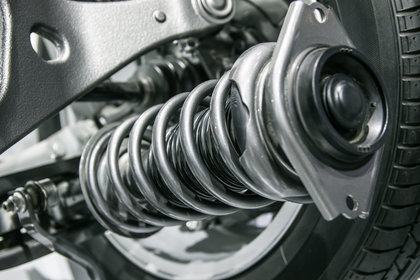
27/07/2017
EGEA at work to define a suspension test standard
Massimo Brunamonti
The European Garage Equipment Association has recently decided to create a specific working group with the aim of defining a product standard for the suspension tests equipment, trying to identify a viable and cost-effective solution for anyone in Europe and around the world who wants to introduce this test in their periodic vehicle inspection checks.
Issues surrounding suspension tests have long been on the table of Europe’s responsible authorities on vehicle inspections. As it is well known, suspensions play a crucial role in vehicle safety : an inefficient or worn out suspension not only reduces driving comfort, but will also affect safety by compromising the tire’s footprint, and grip as a consequence, lengthening braking distances. A car with inefficient suspensions is a potential danger to road safety. Current brake tests, carried out during periodic roadworthiness checks do not actually bring into action the suspension system whose efficiency remains unknown.
Several methods of suspension testing have been proposed over the years, but methodological uncertainty and discord between different solutions, some of which are owned by a number of manufacturers, have so far made it impossible to adopt one of them as a European standard. The Directive 2014/45 itself does not actually provide for a mandatory instrumental test , and the European Commission, aware of the problem, is still working on it.
And now, finally, someone has started to report major results on a large scale. This is the case of Belgium, which introduced mandatory suspension test on periodic roadworthiness inspections several years ago. The Belgian system, managed by GOCA, the national inspection authority, uses a testing equipment developed from the "old" EUSAMA method so popular in the 1960s. The equipment adds to the EUSAMA method, based on the measuring of minimum dynamic loading and wheel static loading, a “minimum phase shift”, the ratio of which is showed in a percentage that must fall within a set limit. The principle, in a nutshell, shows the ability of the suspension unit to keep the wheel in contact with the road even in the most difficult situations.
EGEA, the European Garage Equipment Association has, for years now, been involved in everything that relates to equipment for roadworthiness tests, and has recently decided to create a specific working group with the aim of defining a product standard for such equipment, capable of representing a viable and cost-effective solution for anyone in Europe and around the world who wants to introduce suspension tests in their periodic vehicle inspection checks.
The original EUSAMA standard, modified with the so-called "minimum phase shift", as originally proposed by the American SAE, and subsequently adopted by GOCA, provides the main framework. The purpose of EGEA's work is to define product specs, approval procedures and testing standards to be included in periodic tests of vehicles below 3.5 tonnes.
The Belgian experience encourages the choice: the method has been systematically operating since 2011 and since then, all circulating vehicles have and are being tested also as far as suspensions are concerned, which means about 4.5 million vehicles inspected every year. Single case studies and the resulting database is largely representative of the vehicles in circulation, so much so that it is now a model that can be used in any other European countries as well.
EGEA's work, still at the initial phase, should be completed over a period of about one year, at the end of which a text will be submitted to the competent European and national authorities.
Several methods of suspension testing have been proposed over the years, but methodological uncertainty and discord between different solutions, some of which are owned by a number of manufacturers, have so far made it impossible to adopt one of them as a European standard. The Directive 2014/45 itself does not actually provide for a mandatory instrumental test , and the European Commission, aware of the problem, is still working on it.
And now, finally, someone has started to report major results on a large scale. This is the case of Belgium, which introduced mandatory suspension test on periodic roadworthiness inspections several years ago. The Belgian system, managed by GOCA, the national inspection authority, uses a testing equipment developed from the "old" EUSAMA method so popular in the 1960s. The equipment adds to the EUSAMA method, based on the measuring of minimum dynamic loading and wheel static loading, a “minimum phase shift”, the ratio of which is showed in a percentage that must fall within a set limit. The principle, in a nutshell, shows the ability of the suspension unit to keep the wheel in contact with the road even in the most difficult situations.
EGEA, the European Garage Equipment Association has, for years now, been involved in everything that relates to equipment for roadworthiness tests, and has recently decided to create a specific working group with the aim of defining a product standard for such equipment, capable of representing a viable and cost-effective solution for anyone in Europe and around the world who wants to introduce suspension tests in their periodic vehicle inspection checks.
The original EUSAMA standard, modified with the so-called "minimum phase shift", as originally proposed by the American SAE, and subsequently adopted by GOCA, provides the main framework. The purpose of EGEA's work is to define product specs, approval procedures and testing standards to be included in periodic tests of vehicles below 3.5 tonnes.
The Belgian experience encourages the choice: the method has been systematically operating since 2011 and since then, all circulating vehicles have and are being tested also as far as suspensions are concerned, which means about 4.5 million vehicles inspected every year. Single case studies and the resulting database is largely representative of the vehicles in circulation, so much so that it is now a model that can be used in any other European countries as well.
EGEA's work, still at the initial phase, should be completed over a period of about one year, at the end of which a text will be submitted to the competent European and national authorities.






